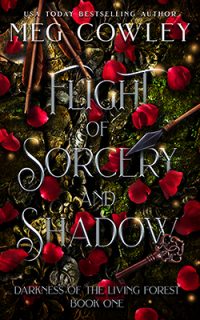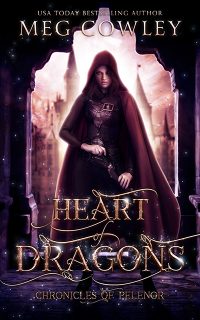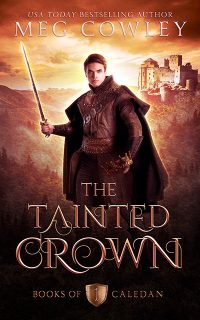Author Interview — December 2021
See behind the scenes with USA today Bestseller meg cowley
In depth Q&A on writing, publishing, and author life, plus fun quickfire questions to get to know the author.
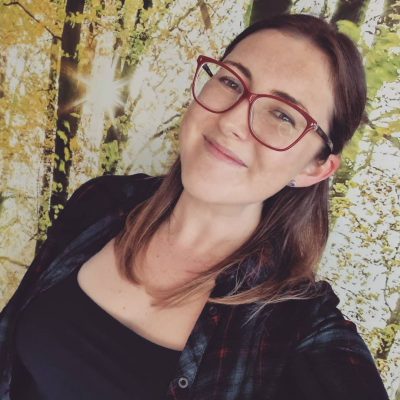
When did you first realize you wanted to be an author?
I’ve written and illustrated for as long as I can remember. Finishing a novel-length story for the first time was inspired by meeting fantasy author Christopher Paolini, at a rare UK book signing.
He spoke so passionately, eloquently, and vividly of writing that it inspired me to finally finish that story idea that wouldn’t leave me alone.
That story became The Tainted Crown, my debut novel and an SPFBO 2018 Semi-Finalist.
How did you become an author?
I knew when I met Christopher Paolini that I just had to get this story down. If I didn’t then it would never happen, and I either had to follow my passion or turn my back on it. It was only when I’d finished writing it, because I’d really written it just for myself, that I realised that the story not only had more to be told (and that became the rest of the trilogy – The Brooding Crown and The Shattered Crown), but that I really wanted to share it with others.
Deep down, I’d always wanted to be an author…but I didn’t dare to dream that I’d ever be able to accomplish that. I think fear turns us away from a lot of things in life if we’re not careful and it can be so insidious we don’t even realise.
There came a moment where I had to stand up for what was important to me. Did I want to continue working in jobs I hated, ones that made my soul turn grey and my heart despair, because that’s what society tells us we should do…or did I want to take a chance and pursue the craziest dream ever, of becoming not only a published author, but a full time one? I chose the latter.
It wasn’t easy and it’s taken years in the making, but it was the right thing for me. This is my calling. In my heart, I always knew that. I’m really honoured to be a full-time storyteller now.
Why did you independently/self-publish rather than traditionally?
When I was close to finishing drafting my first book, I began to look into publishing. At the time, self-publishing was still relatively new and viewed with a lot of stigma. It still has plenty of stigma these days, though that is diminishing, and I am so proud to be a part of an industry on par with and in many areas excelling compared to traditional publishing.
When it came to my decision, I had to weigh my priorities. I wanted to write great stories, reach readers, and make enough money to be able to sustain a full-time career. Only self/indie-publishing offered all three. With traditional publishing, I would have struggled to even attract enough notice to become published no matter how good my books might have been. And, since many traditional publishing deals are financially terrible at best, not to mention with shockingly exploitative contracts, at the time, it was a stark choice. And an easy one.
I would always be open to traditionally publish in the future – for a fair contract and advance/royalty arrangement. But right now, indie publishing allows me to pursue a full-time writing career, write great books and get them directly into the hands of readers who love them. It’s an honour, and I am so grateful for indie publishing for facilitating this.
How long does it take you to write a book?
It depends – the longer the book, the longer it takes to write! However, equally, the more practise at writing I have, the faster I get.
It took me six years to finish The Tainted Crown, but now it takes on average roughly two to three months to plan, draft, and edit a full-length fantasy novel.
That’s comprised of one-two weeks of detailed planning and plotting, six-eight weeks of first drafting, and one week of revisions, and one week of editing.
Then, the book is ready for a final proofread ahead of going to my advance readers and then publishing!
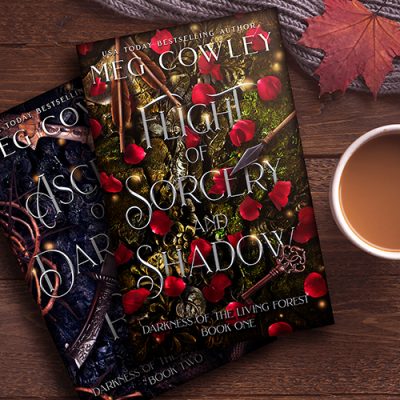
What is your work schedule like when you're writing?
In the ideal world (free of cats, children, and adult responsibilities!), I’d get up and write immediately. My brain works best in the morning, before it gets cluttered with other things. That being said, I’m the mother of a small child, so I don’t roll out of bed to my desk anymore, but once he’s gone to school, I start my writing for the day.
I typically spend all morning writing (until my brain burns out!), then refuel with some lunch, and spend most afternoons on the numerous admin and marketing tasks that being an indie author requires. I only write on ‘school days’ and spend my non-writing time with my family.
I love my career so it’s dangerously easy to throw myself into it to the absence of all else – it’s really important to me to balance that with quality family time, and also time to engage in other hobbies (you know, outside writing and reading, of course!).
Where do you get your ideas?
My ideas usually start with a vivid character or set of characters who stroll into my mind and won’t leave me alone! A world unfurls around them and one interesting scenario that leads to another… that’s all I need to go charging off on the adventure of a new book or series.
For my Books of Caledan series, it was Soren who appeared first. He went through several names. ‘Aung’ first of all. Then ‘Caelin’. Before I finally settled on Soren which fit the story and character better. It’s a Scandinavian name that means ‘serious’ which Soren very much is – he weighs up decisions so carefully because he knows that they affect so many more people than himself.
For my Chronicles of Pelenor quartet, it was Aedon who waltzed in, fully formed, and I had to write about this vivacious, charming, and enigmatic thief…the rest of the world unfurled around him. He was such a diva, he even got his own follow-up series in the Darkness of the Living Forest trilogy.
What is your writing process like?
I plan my novels first, writing out in as much detail as I can everything I know about the characters, world, plot, and anything else that’s coalesced. I make sure to fill in all the gaps, and that the storyline is a satisfying read with i.e. a beginning, middle, and end (ok, it’s a little more complicated than that, but you get the picture!).
The plotting part of story writing is one of my absolute favourite parts. It’s like a spider weaving a web, or putting together a jigsaw puzzle – where you have to make the pieces. I find it so satisfying to craft a rich and complex plot, knowing that everything fits together seamlessly, before I start to tease out the story in the first draft.
After the planning stage, and usually without waiting (because I am very impatient and passionate and like to get started!) I write! I draft the entire book. Once its drafted, I let it rest for a day or two (maximum…again, I’m really impatient…), and then dive in with my (digital) red pen. I edit the text, reading through it dozens of times. In each edit, I search for something different; it could be to check the story flows, a character arc isn’t missing anything, right down to the nitty gritty of checking for spelling/grammar/punctuation errors and my own bad writing habits.
Once I’m done with it, off it goes to my editor. When it returns, I make the recommended edits, and send it out to my proof-reader for a spell/sense check (and to hunt out typos which I am pretty sure sneak in after all the editing is done). Once the final edits are done, it goes to my advance reader team, who help me spread the word on launch day!
How do you decide what happens next in a story?
It’s a mix of logic, planning…and creative unleashing! I plot my books rigorously and follow a beat-led story structure that I’ve refined from various sources over the years and continue to evolve.
That guides me in terms of things like making sure I have rising and falling tension, and a good climax, but really the magic of a story comes from the characters within. They always drive it for me. Whatever I write, I always try to do it wearing the character’s shoes, making the choices that they would naturally make based on their personality and circumstances. Each character would lead to a very different story if placed in the same situation!
For example, if a character met a dragon…Morrigan might try to enslave it, Aedon might try and steal its treasure, Soren would try and strike an allegiance with it, and so on! I find being true to characters the best way to overcome any blocks in the story. I ask, ‘what would this character do?’ and it always gives an answer that leads in fun directions!
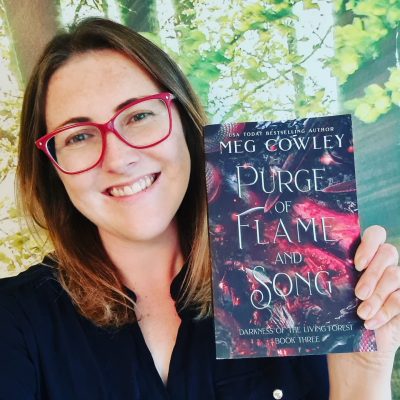
What was your hardest scene to write?
That depends on the series!
Books of Caledan…Near the end of book three, The Shattered Crown. Brithilca. In case you haven’t read it yet, I won’t spoil it here. It’s a scene my readers resonate with too.
Chronicles of Pelenor…near the end of book four, Mark of Fate. Erica and Brand. I cried writing that, but it was a moment I had known would happen since the start of the first book.
Darkness of the Living Forest…near the end of book three, Purge of Flame and Song. Morrigan’s bittersweet arc was so challenging to write and I desperately wanted to get it right for her and for everyone who read it.
What is the most difficult part of your artistic process?
Overcoming self-doubt. It is crippling when it takes hold. Writing means sharing the vulnerable parts of my soul with the world, and that’s a scary thing. Self-doubt is the internal voice that tries to stop me doing that by any means and it can be quite vicious and cruel. I have to push through, disregard that voice, and keep going until the story is written.
I don’t think the self-doubt ever goes away but I won’t let it stop me! I remind myself that I am honoured to do what I love and positivity from readers matters a lot in negating the self-doubt.
Do you read your book reviews? How do you deal with bad or good ones?
I read every single one! I mostly ignore the bad ones – unless they give good constructive feedback. In that case, I always contemplate it in case it’s something I can improve on in future. Positive reviews make me incredibly grateful, reassure the ever-present voice of self-doubt, and motivate me to keep going.
If you could tell your younger writing self or aspiring writers anything, what would it be?
Keep writing, dreaming, believing. Wonderful things lay ahead!
If you didn’t write, what would you do for work?
I’d be a fantasy artist – I’ve always been creative and love to illustrate, especially fantastical creatures.
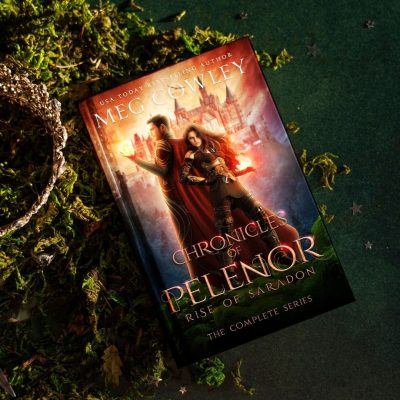
What literary pilgrimages have you undertaken?
I’ve visited the Harry Potter Studios in Leavesden, as I was a huge Harry Potter fan growing up. That was really fun! The sets and props are amazing, but I want a real wand a broomstick, please.
I also visited Trinity College Library in Dublin. Hands down one of the most beautiful libraries in the world. There, I saw some amazing old books like the Book of Kells and the Book of Meath. It brought a lump to my throat to see and read a thousand-year-old book. As a reader and author, that was a profound moment.
10 Quickfire Questions…
- What would you choose as your mascot/avatar/spirit animal?
Cat or dragon! - Which movie character did you have a crush on growing up?
Legolas! (Pointy ears, long hair, brooding stare… yep. I cringe now!) - Favourite scent?
Lavender (I love Lemon & Lavender Yankee candles). - What food could you not live without?
Margherita pizza. - What interesting skill would you like to learn?
Sword fighting! - If you could create a holiday, what would it be?
International Reading Day, of course. (And everyone would have to take the day off and read a great book.) - What dance move are you amazing at?
Literally none, I have about seven left feet! - If you could live anywhere, where would you choose?
French Alps. (I love mountains and forests – hiking in the summer and skiing in the winter, plus lots of writing time in a pretty chalet!) - What super power would you have?
Flying! (Wouldn’t that be fun and practical? Goodbye traffic jams.) - Coffee or tea?
Tea, always. (Earl Grey preferably!)
TALES OF TIR-NA-ALATHEA
Duty-bound to kill each other—now they must ally to survive. But what else will bloom in the darkness between them?
This complete dark romantic fantasy is filled with enemies to lovers, strong heroines, found family, betrayal, hope, and redemption. It’s perfect for fans of SJ Maas’ Throne of Glass and Elise Kova’s Air Awakens.
CHRONICLES OF PELENOR
She will never survive the elven court—or him. Sworn enemies and tangled loyalties burn in the face of old magic and rising evil.
Filled with intrigue, betrayal, adventure, enemies to lovers romance, twisting plot, found family, and redemption, the Chronicles of Pelenor: Rise of Saradon series is perfect for fans of SJ Maas’ Throne of Glass and Sylvia Mercedes’ Venatrix Chronicles.
BOOKS OF CALEDAN
An exiled prince’s crusade for justice and a heartrending journey of grief, identity, and healing against an epic backdrop.
Discover an epic, coming-of-age fantasy in the 100,000 bestselling Books of Caledan. Perfect for fans of Christopher Paolini and Alison Croggon.
social media
Keep up to date with the latest Meg Cowley news on social media.
© meg cowley 2021
Join my reader's group
Thank you! You have successfully joined Meg Cowley's Reader Club. Please at meg@megcowley.com to your contacts and look out for your confirmation email.
